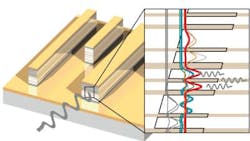Quantum-cascade lasers could be powered by heat
| A schematic of a quantum-cascade laser (QCL) shows layers of different semiconductor material within the device, producing the band structure shown in the inset. (Graphics: Christoph Deutsch) |
Innsbruck, Austria--Researchers Kathrin Sandner and Helmut Ritsch at the University of Innsbruck have predicted via a model that a quantum-cascade laser (QCL) could be created that would be directly powered by a temperature gradient between the laser's pump and gain regions -- in other words, by heat. Two tunnel-coupled wells at different temperatures and a very high-quality resonator are required. Because it runs on heat, the laser could be considered to be cooling itself.
In a QCL semiconductor cascade layer, “electrons are transferred through this structure in a specific series of tunneling processes and quantum leaps, emitting coherent light particles,” says Ritsch. “Between these layers the electrons collide with other particles, which heats the laser.” Thus, QCLs only work as long as they are strongly cooled. When too much heat is produced, the laser stops emitting.
The two physicists propose that the heating effect in QCLs could not only be avoided but, in fact, reversed through a modification of the thickness of the semiconductor layers.
“A crucial part is to spatially separate the cold and warm areas in the laser,” says Sandner. “In such a temperature-gradient-driven laser, electrons are thermally excited in the warm area and then tunnel into the cooler area where photons are emitted.” This produces a circuit where light particles are emitted and heat is absorbed from the system simultaneously.
“Between the consecutive emissions of light particles a phonon is absorbed and the laser is cooled,” notes Sandner. "When we develop this idea further, we see that the presence of phonons may be sufficient to provide the energy for laser amplification Such a laser could be powered without using electric current."
REFERENCE:
1. K. Sandner and H. Ritsch, Physical Review Letters (2012); DOI: 10.1103/PhysRevLett.109.193601
